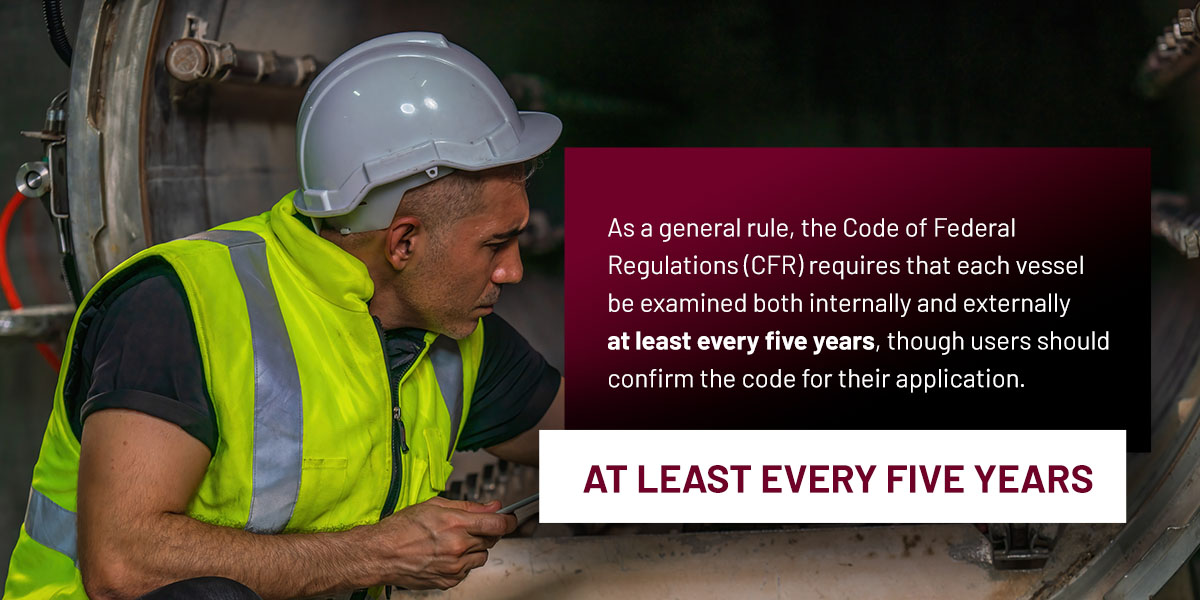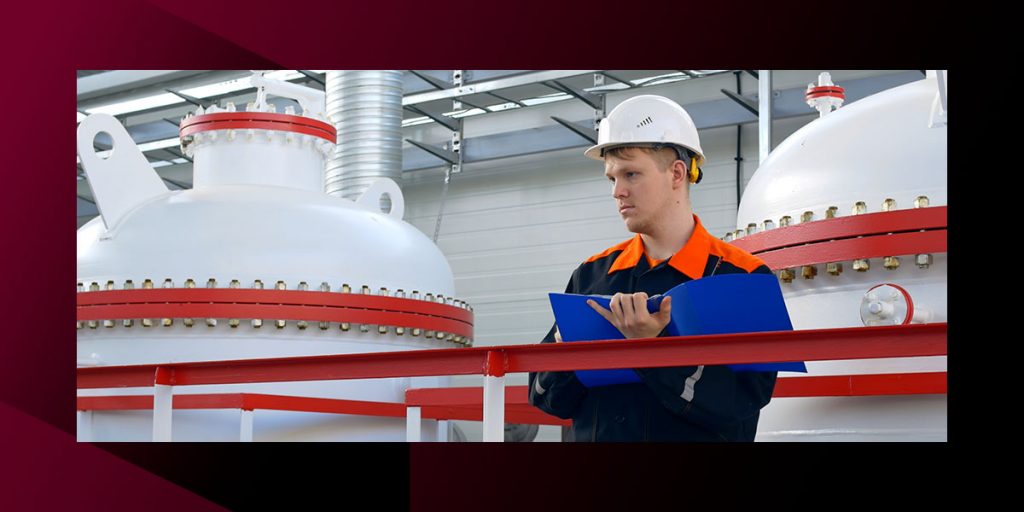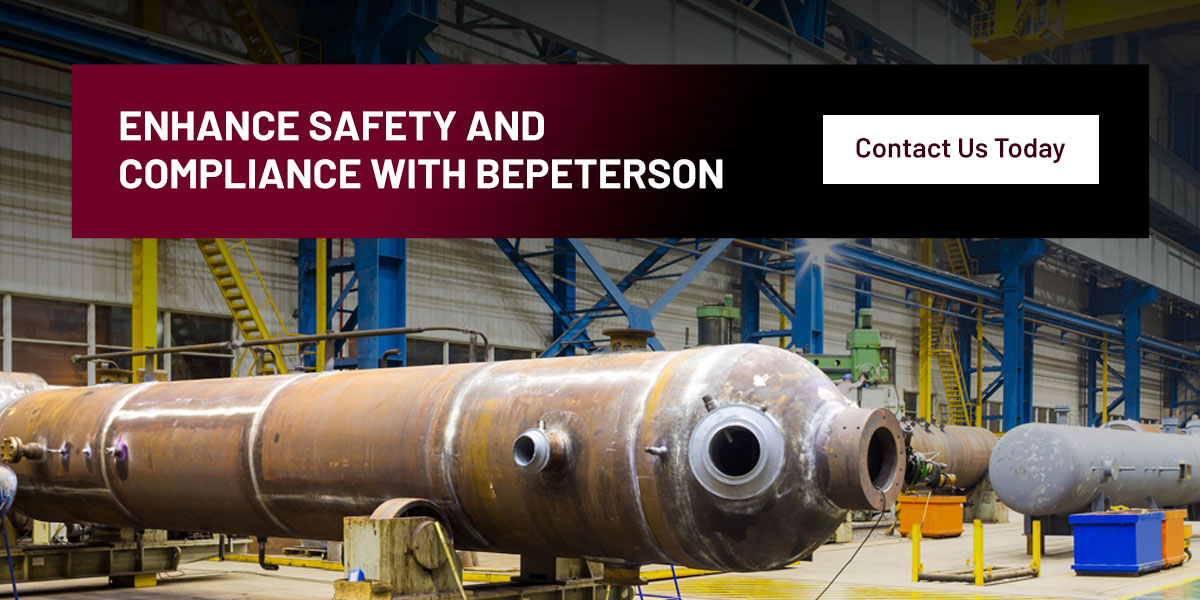Pressure Vessel Inspection and Maintenance
Pressure vessels store fluids at different pressures. In the U.S., most pressure vessels are designed according to the American Society of Mechanical Engineers (ASME) safety guidelines. However, that doesn’t guarantee their long-term operational reliability. This is because these vessels are used to hold different toxic and non-toxic fluids, which may impact their performance.
Regular inspections are essential in high-stakes industries, including defense, chemical, industrial, oil and gas. Although time-consuming, pressure vessel inspection and maintenance help avoid any type of untoward incident. Periodic checks can ensure these containers are in good working order and don’t pose a threat.
The Importance of Pressure Vessel Inspection, Maintenance and Testing
Beyond increasing the operational life of these pieces of equipment, periodic inspections and testing are vital for several other reasons. These procedures minimize the risk of pressure vessel failure and improve the safety of users, property and the environment.
Pressure vessels are used in high-risk industrial environments, making inspection challenging. Yet if any weak spots are ignored, they may affect the performance of the vessel, causing losses from unplanned downtime. A scheduled maintenance program minimizes interruptions and can yield long-term cost savings by preventing emergency repairs and equipment breakdowns.
Unaddressed defects can escalate into structural failures, threatening personnel and property. Pressure vessel maintenance procedures can reduce the likelihood of such catastrophes.
Maintenance at various intervals is also mandated by different industry standards. Regular inspections are essential to staying compliant with regulatory bodies such as the Occupational Safety and Health Administration (OSHA) and avoiding penalties related to violations.
The Different Maintenance Strategies
Maintenance involves inspections, testing and the repair or replacement of defective and worn parts. Equipment manufacturers establish various pressure vessel maintenance requirements. Preventive maintenance is one of the most important types of manufacturer-mandated maintenance programs. It is performed at regular intervals to avoid the complete breakdown of a vessel.
On the other hand, breakdown maintenance is performed when the equipment or any of its parts fail to perform as a result of an unforeseen defect. If you notice any of the following signs, the PV should be removed from service pending an inspection:
- Material degradation: Any cracking, pitting, corrosion or discoloration.
- Mechanical issues: Misaligned piping or loose fasteners.
- Component malfunction: Seized latches or stiff valves.
The Types of Pressure Vessel Inspections and Tests
A robust maintenance plan will address all potential damage mechanisms, including various types of inspections and non-destructive testing (NDT) methods. These must be performed by certified professionals only, as they are trained in identifying the weak areas of a pressure vessel. They will also select the testing and inspection procedures and intervals based on each vessel’s specific characteristics and circumstances of use.
Let’s take a look at the different types:
Inspection Type Matrix
| Dimension | Internal | External | Out-of-service | In-service |
|---|---|---|---|---|
| Definition | Inspection of vessel interior when empty and not operating | Inspection performed on the outside while operating | Conducted when shut down to allow full access | Conducted while in operation without halting processes |
| Focus areas | Wear/corrosion near connections, seams, welded nozzles, weld-adjacent areas | Inlet/outlet piping, vessel connections, external components | Comprehensive structural integrity (areas inaccessible during operation) | Emerging external issues during use |
| Goal | Identify internal degradation | Verify external condition and operation | Holistic integrity assessment | Early detection without downtime |
Internal vs. External
There are two main types of pressure vessel inspections — internal or external.
An internal inspection is performed when the pressure vessel is empty and not in operation. It is mainly conducted to identify wear or corrosion, especially around crucial internal components like vessel connections, seams and welded nozzles, and areas near welds, external controls or fittings.
As the name suggests, an external inspection is conducted outside the vessel when it is in operation. During such an inspection, the inspector examines the workings of external components such as inlet and outlet piping and vessel connections.
Out-of-Service vs. In-Service
Inspections are also categorized as either out-of-service or in-service.
Out-of-service inspections are conducted when the vessel is shut down, allowing for a thorough internal and external assessment of its structural integrity, especially in areas inaccessible during operation. In-service inspections monitor the vessel’s external conditions while in use, detecting emergent issues without halting operations.
NDT Methods
The inspection process uses NDT methods to examine the vessel without causing damage, including:
| Method | Purpose | Detects | Materials/Notes |
|---|---|---|---|
| Ultrasonic testing (UT) | Measure wall thickness; find internal defects | Internal corrosion, thinning, cracks | High-frequency sound waves |
| Radiographic testing (RT) | Image internal structure | Subsurface defects, weld discontinuities | X-rays or gamma rays |
| Magnetic particle testing (MT) | Reveal surface/near-surface cracks on ferromagnetic materials | Cracks, discontinuities | Requires magnetization and iron particles |
| Dye penetrant testing (PT) | Expose surface-breaking defects | Surface cracks and flaws | Works on ferrous and nonferrous materials |
- Ultrasonic testing (UT): UT employs high-frequency sound waves to accurately measure wall thickness and detect internal defects like cracks or corrosion.
- Radiographic testing (RT): RT uses gamma rays or X-rays to image the vessel’s internal structure, revealing subsurface defects and weld discontinuities.
- Magnetic particle testing (MT): Specifically designed for ferromagnetic materials, MT uses an applied magnetic field and iron particles to expose near-surface and surface cracking.
- Dye penetrant testing (PT): PT applies a liquid dye to expose surface-breaking defects, such as cracks, in ferrous and nonferrous materials.
Regulatory and Industry Standards
Inspections must be conducted in adherence to established regulatory and industry guidelines. Most inspectors abide by the ASME pressure vessel inspection requirements. They may also follow protocols set by the National Board Inspection Code.

Different industry standards mandate pressure vessel maintenace at various intervals. As a general rule, the Code of Federal Regulations (CFR) requires that each vessel be examined both internally and externally at least every five years, though users should confirm the code for their application.
The frequency and scope of inspection should also depend on hazard potential — the vessels that store hazardous contents may require more regular, in-depth inspection compared to the ones that store relatively non-hazardous fluids. For instance, heating boilers may require external inspection every couple of years, whereas corrosive pressure vessels may require internal and external inspection at shorter intervals.
Typical Inspection Checklist
Here is a step-by-step checklist for a standard inspection:
1. Conducting a Visual Examination
Starting with a comprehensive visual assessment, inspectors will carefully look for indications of external damage or material degradation, such as:
- Bulging
- Buckling
- Distortion
This step informs the scope of subsequent, more in-depth evaluations.
2. Identifying Corrosion and Material Degradation
Detecting corrosion and material degradation is vital to help ensure the longevity and long-term safety of the equipment. External checks involve inspecting insulated areas, as these can allow moisture to enter the vessel. For internal inspections, refractory linings or metal cladding are examined.
3. Evaluating Seals and Joints
Joints and seals can be common sources of failure. Welded joints endure high stress, whereas seals are made from material prone to degradation due to pressure, heat or chemical attack. A thorough inspection will verify these components’ performance and identify flaws that could compromise vessel safety.
4. Performing Pressure Tests
Inspections are often followed by different types of pressure tests, which confirm the vessel’s capacity to maintain internal pressure without leakage or structural deformation:
- Hydrostatic tests: This is one of the important ways in which pressure vessels such as boilers, fuel tanks, and pipelines are tested for their leaks as well as strengths.
- Pneumatic tests: These tests demand a high level of potential energy, which is why they are only performed whenever required. Pneumatic tests are necessary when the pressure vessels cannot be filled with water or where the traces of a testing medium are not recommended or allowed.
- Leak tests: Vacuum and pressure vessels are subjected to leak tests to confirm their maximum permissible leak specified in the document.
- Mechanical integrity tests: These tests are conducted to check for buckling or the instability of vacuum chambers.
The CFR’s pressure vessel testing requirements mandate hydrostatic tests when inspectors find safety-critical defects. Routine hydrostatic and pneumatic tests must also be performed at least twice every five years.
5. Documenting and Reporting Inspection Findings
The inspection concludes with a formal report detailing all findings. This documentation is vital for compliance and subsequent maintenance planning, and must include:
- All test results
- Inspection times and dates
- A complete assessment of the vessel’s performance and condition
Enhance Safety and Compliance With BEPeterson
Knowing the nature of pressure vessel utilization, it is important to source them from a trusted manufacturer like BEPeterson. We have been providing custom pressure vessels designed and manufactured according to ASME standards for over 80 years. Complementing our superior construction, we conduct thorough inspections to help you meet industry and regulatory requirements for safety and compliance.
To learn more about our pressure vessel solutions, email sales@bepeterson.com or call us at 508-501-0660 today.



Pingback: Cogen Ducts and Roof Stacks of Quality - BEPeterson
Pingback: Identifying Fatigue Points in Pressure Vessels - BEPeterson
Pingback: Frequent Pressure Vessel Inspection - BEPeterson